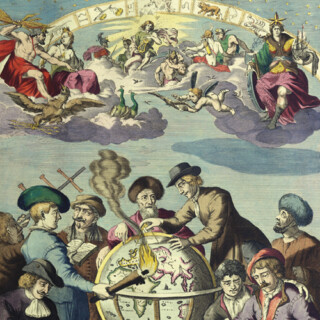The Verney Copy of the first edition of the Quartermaster’s Map
The kingdome of England & principality of Wales exactly described
whith every sheere & the small townes in every one of them : in six mappes, portable for every mans pocket
[London],
Thomas Jenner,
1644.
Folio (425 by 305mm). Engraved title and 6 maps tipped in and made up to size, contemporary calf with roll tool gilt border, rebacked retaining original spine.
425 by 305mm. (16.75 by 12 inches).
18275
notes:
During the English Civil War, Parliamentarian publisher Thomas Jenner worked alongside Royalist supporter and newly arrived immigrant Wenceslaus Hollar to produce a detailed map of England and Wales. A reduced version of Christopher Saxton's 1583 map, it is printed on six sheets, with the western tip of Cornwall printed on a separate smaller piece of paper and glued on. It became known as the 'Quartermasters' Map',
perhaps because of the importance of this leading mil...
perhaps because of the importance of this leading mil...
bibliography:
NHG Hollar 550-554; Pennington 652-7.
provenance:
Provenance:
1. Inscription of Edmund Verney (1636-1688)
On the verso of the title:
"This booke is myne, Edmund Verney, Anno Domini 1666"
Verney's grandfather, Sir Edmund Verney, had held the position of Standard Bearer to Charles I, and died at Edge Hill in 1642, some two years prior to the publication of the map.
2. Bookplate of Syston Park
From the Thorold Collection at Syston Park, Lincolnshire. Syston Park was once owned by the Verney family.
1. Inscription of Edmund Verney (1636-1688)
On the verso of the title:
"This booke is myne, Edmund Verney, Anno Domini 1666"
Verney's grandfather, Sir Edmund Verney, had held the position of Standard Bearer to Charles I, and died at Edge Hill in 1642, some two years prior to the publication of the map.
2. Bookplate of Syston Park
From the Thorold Collection at Syston Park, Lincolnshire. Syston Park was once owned by the Verney family.







![HOLLAR, W[enceslaus] The kingdome of England & principality of Wales exactly described](https://i0.wp.com/crouchrarebooks.com/wp-content/uploads/2025/03/18275_1H.jpg?fit=3500%2C2540&ssl=1)
![HOLLAR, W[enceslaus] The kingdome of England & principality of Wales exactly described](https://i0.wp.com/crouchrarebooks.com/wp-content/uploads/2025/03/18275_2H.jpg?fit=3500%2C2510&ssl=1)
![HOLLAR, W[enceslaus] The kingdome of England & principality of Wales exactly described](https://i0.wp.com/crouchrarebooks.com/wp-content/uploads/2025/03/18275_3H.jpg?fit=3500%2C2534&ssl=1)
![HOLLAR, W[enceslaus] The kingdome of England & principality of Wales exactly described](https://i0.wp.com/crouchrarebooks.com/wp-content/uploads/2025/03/18275_4H.jpg?fit=3500%2C2525&ssl=1)
![HOLLAR, W[enceslaus] The kingdome of England & principality of Wales exactly described](https://i0.wp.com/crouchrarebooks.com/wp-content/uploads/2025/03/18275_5H.jpg?fit=3500%2C2287&ssl=1)
![HOLLAR, W[enceslaus] The kingdome of England & principality of Wales exactly described](https://i0.wp.com/crouchrarebooks.com/wp-content/uploads/2025/03/18275_6H.jpg?fit=3500%2C2553&ssl=1)
![HOLLAR, W[enceslaus] The kingdome of England & principality of Wales exactly described](https://i0.wp.com/crouchrarebooks.com/wp-content/uploads/2025/03/18275_7H.jpg?fit=3500%2C2518&ssl=1)
